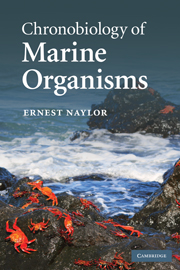Book contents
- Frontmatter
- Contents
- Preface
- 1 Moonshine
- 2 Biorhythms of coastal organisms
- 3 Tidal and daily time-cues
- 4 Clocks and compasses
- 5 Lunar and semilunar biorhythms
- 6 Annual biorhythms
- 7 Plankton vertical migration rhythms
- 8 Staying put in estuaries
- 9 Ocean drifters
- 10 Living clockwork
- References
- Author index
- Subject index
- Plate section
7 - Plankton vertical migration rhythms
Published online by Cambridge University Press: 05 June 2012
- Frontmatter
- Contents
- Preface
- 1 Moonshine
- 2 Biorhythms of coastal organisms
- 3 Tidal and daily time-cues
- 4 Clocks and compasses
- 5 Lunar and semilunar biorhythms
- 6 Annual biorhythms
- 7 Plankton vertical migration rhythms
- 8 Staying put in estuaries
- 9 Ocean drifters
- 10 Living clockwork
- References
- Author index
- Subject index
- Plate section
Summary
Almost throughout the oceans and seas…as night approaches very great quantities of animals migrate upwards from the deeper, dark waters towards the surface layers, where they spend the night until at dawn they descend again to their daytime residence depths
Alan Longhurst, 1976The first recorded observations of the phenomenon of vertical migration by aquatic animals were published early in the nineteenth century, by naturalists studying the plankton of freshwater lakes (Cushing, 1951). By the end of that century pioneering biological oceanographers had also observed that greater numbers of plankton animals were caught at the sea surface at night than by day. It was then that the hypothesis was first formulated that marine zooplankton undertook daily rhythms of vertical migration. Later, oceanographers began to utilize specially designed tow nets to capture plankton at different depths throughout the day and night and so test the hypothesis. There were initial difficulties in interpreting early findings since the first tow nets to be used were open when they were lowered into the water and remained open until they were hauled on deck (Murray, 1885). So, although the nets were towed at a particular depth for a known interval of time, they inevitably also caught plankton on the way down and on the way up, clearly presenting problems when trying to determine the precise depth at which particular animals were collected.
- Type
- Chapter
- Information
- Chronobiology of Marine Organisms , pp. 134 - 149Publisher: Cambridge University PressPrint publication year: 2010



